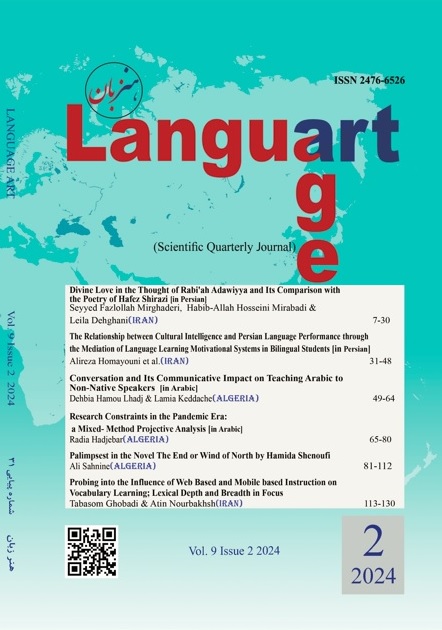Automatic Processing of the Semantic Level through Ontology Construction (A Case Study of Motion and Stasis Verbs)
DOI:
https://doi.org/10.22046/LA.2024.10Keywords:
Semantic Field, Motion and Stasis Verbs, Semantic Relations, OWL, OntologyAbstract
Computational linguistics focuses on formalizing language characteristics and rules for computer processing. While Arabic has successfully employed artificial intelligence in computational phonology, morphology, and syntax, semantic-level processing remains challenging. The core issues involve enabling computers to: (1) understand natural language with human-like comprehension, and (2) distinguish between literal and metaphorical word meanings to reduce the semantic ambiguity plaguing Arabic in digital environments. This study proposes an ontology-based methodology for Arabic semantic processing. Focusing on the semantic field of motion and stasis verbs, we extracted verb meanings from the "Ma'ajim Al-Ma'ani" dictionary and analyzed their interrelations. The resulting semantic network formally represents relationships between these verbs. Using the Web Ontology Language (OWL) - which enables systematic organization, classification, and linking of meanings - we developed an ontology that facilitates both human and machine interpretation.
References
الزراعي، حسين بن علي (2013). بناء الكلمة وتحليلها مقاربات في اللسانيات الحاسوبية. ط1. الجزائر: دار التنوير.
عزوز، أحمد (2002). أصول تراثية في نظرية الحقول الدلالية -دراسة-. دمشق: دار اتحاد الكتّاب العرب.
عمر، أحمد مختار (1998). علم الدلالة. ط5. القاهرة: دار عالم الكتاب.
المالكي، طارق (2015). أنطولوجيا حاسوبية للنحو العربي، نحو توصيف منطقي ولساني حديث. ط1. المغرب: دار النابغة للنشر والتوزيع.
سيد النشرتي، مؤمن (2014). نحو التكامل المعرفي من واقع توظيف الأنطولوجيات في أطار التنقيب عن البيانات : دراسة تحليلية.2, معرفة. Available at: https://search.emarefa.net/ar/detail/BIM-661502 (Accessed: April 14, 2022).
Al-Maliki, T. (2015). Computational ontology of Arabic grammar: Towards a modern logical and linguistic description (1st ed.). Dar Al-Nabigha.
Al-Zira'i, H. B. A. (2013). Word construction and analysis: Computational linguistics approaches (1st ed.). Dar Al-Tanweer.
Azzouz, A. (2002). Heritage foundations in semantic field theory: A study. Ittihad Al-Kuttab Al-Arab.
Jean Berco-Gleason )1982). Insight from child acquisition for second language loss, in Lambert and Freed.
Lyons, J. (1996). Semantics. Cambridge: Cambridge Univ. Press
Omar, A. M. (1998). Semantics (5th ed.). Alam Al-Kutub.
Owl (2012). OWL - Semantic Web Standards. Available at: https://www.w3.org/OWL/ (Accessed: April 14, 2023).
Sayyid Al-Nasharti, M. (2014). Towards cognitive integration from the reality of employing ontologies in data mining: An analytical study. Ma’rifa, *2*. https://search.emarefa.net/ar/detail/BIM-661502 (Accessed April 14, 2022).
Www.almaany.com (2010). Available at: https://www.almaany.com/ar/dict/ar-en/ (Accessed: April 04, 2021).
Downloads
Published
How to Cite
Issue
Section
License
Copyright (c) 2024 راضية حجبار

This work is licensed under a Creative Commons Attribution 4.0 International License.

